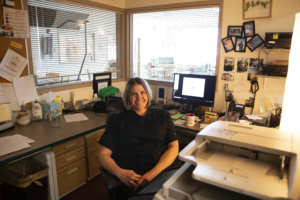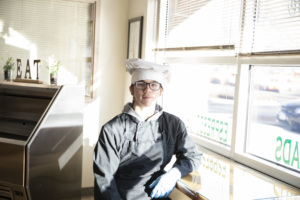
Charles McGinnett preps meals in the Mesa County Valley School District 51 Career Center’s Fresh Side Cafe in Grand Junction. Photos by Luna Anna Archey
Charles McGinnett preps meals in the Mesa County Valley School District 51 Career Center’s Fresh Side Cafe in Grand Junction. Photos by Luna Anna Archey
As the recent Thanksgiving Day holiday approached, school district officials in Grand Junction were in a bind.
COVID-19 outbreaks, other respiratory illnesses and staff shortages had all challenged the district since classes began in August. And now, the turkey was in jeopardy.
Mesa County Valley School District 51 has had a long tradition of serving what is fondly referred to as a “turkey/gravy” meal for students the day before the start of Thanksgiving break. Students have come to look forward to the meal—and some to rely on it as the only hot Thanksgiving dinner they will have.
School officials have taken pride in being able to serve the from-scratch, midday meal in a district where more than a third of the 22,000 students qualified for free or reduced-price lunches before a pandemic-era federal program mandated free breakfasts and lunches for all students. At District 51, not to mention many other school districts statewide, schools are considered important sources of nutrition as well as places of learning.
This year, too many of the 40 schools with cafeterias in the districts were suffering what many schools across the state and country were facing: not enough hands on deck, particularly in the cafeterias.
On any given day, out of 130 nutrition-service workers in the Mesa County district, 20-30 positions were unfilled, and still are. Rather than having hot meals, for three weeks leading up to Thanksgiving, students in some of the schools had to bring their own lunches from home or make do with commercially packaged peanut butter and jelly sandwiches or boxes of cheese, lunch meat, crackers and cookies. One day a week, lunches came out of towering stacks of Pizza Hut boxes.
In mid-November, it was looking like the pre-Thanksgiving lunch was going to have to be more of the same. No one was happy about it. Not students. Not their parents. Not the remaining “lunch ladies.” And not school district officials.
“We were in the worst situation we’ve ever been in,” said District 51 Director of Food & Nutrition Services Dan Sharp. “And then we get this silver lining.”
The silver lining came like a story line from an action hero comic. Teams of students called the “Culinary Hotshots” were sent to the cafeterias’ rescue after officials at the district’s Career Center campus put their heads together and forged a solution that is continuing to bring daily hot lunches to students. (The Career Center offers career and technical education in several tracks, including culinary arts and restaurant management.)
The Career Center principal, the professional chef who oversees the center’s Fresh Side Cafe, the director of the In-Steps employment-preparatory program for older students with special needs, and an area school director came up with the idea to recruit students who are studying culinary arts at the career center. The students are already experienced in food preparation, safety and serving through their work in the center’s unique community cafe.
The win-win solution would not only allow district students to continue receiving hot meals. It would give the culinary students real-world experience that would help with their future employment.
The idea for the Culinary Hotshots went from thought to concrete action with it’s-an-emergency speed.
“It began as a ‘what would you think if…?’ discussion, and before you knew it—boom, we’re on it,” said Cam Wyatt, principal of the Career Center.
That “boom” actually stretched over concentrated days of work. It wasn’t as easy as simply dispatching students to schools across the district. Administrators had to get permission from parents to have their children work outside the Career Center. They had to line up transportation. That meant a complicated web of bus passes and even enlisting a few principals as drivers. Certifications had to be checked; students had to be certified in a program called ServeSafe to show they had learned proper food-handling skills.
“We kind of built the airplane while we were flying it,” said Christina Horn, a graduate of the Auguste Escoffier School of Culinary Arts in Boulder who, five years ago, gave up a chef position in one of Grand Junction’s fine dining restaurants to take over teaching culinary students at the Career Center.

Christina Horn, the Career Center’s culinary arts program instructor.
With the procedural hurdles out of the way, the Culinary Hotshots hit the schools in their matching visors with red and orange flames. Their presence on that day before Thanksgiving enabled the cafeterias in District 51 to fill with the unmistakable, appetite-whetting aromas of turkey, mashed potatoes, gravy, green beans, fresh-baked bread and pumpkin cookies.
“We did pretty well. The kids didn’t have to eat Lunchables,” said Charles McGinnett, one of the Culinary Hotshots, as he filled cups with cut fruit for a post-Thanksgiving lunch at Appleton Elementary School.
The Culinary Hotshots have remained on the job since the turkey/gravy meal success. Crews go out each day to four shorthanded schools to help prep the meal for that day. They have had a hand in making lunch items like quinoa salad, marinara pasta sauce, barbecued pork, steamed broccoli, burritos and loaded nachos. Late morning, other crews show up to help serve the hot meals. The crews rotate so that everyone has a chance to do all the jobs.
“This was the worst year,” said Ronda Nelson, an Appleton Elementary School cook who had been preparing food for nearly 300 students per day by herself after other workers became sick on an already shorthanded staff. She called the help she now receives from the Culinary Hotshots “amazing.”
On one recent day, that meant McGinnett, who would like to open his own restaurant someday, was helping to prep food while another Culinary Hotshot, Logan Shroder, who hopes to join the military and become a cook with the U.S. Navy Seabees, washed and stacked industrial-sized cooking pots before the first wave of hungry grade-school students streamed into the cafeteria line.
On the previous day, at the Independence Academy charter school, three of the In-Step students lined up behind a serving counter where spaghetti and meatballs were on tap for that day. They handed out bread, fruit and salads while the director of their program, Kelly Weeks, stood at one end with a clipboard to note how many students were receiving lunches and to make sure each one had a fruit or a vegetable.
“The kids say, ‘good job, thank you,’ and that feels good,” said Tanner Twiggs, who was responsible for placing rolls on each tray next to the pasta.
Liz Dahl, a paraprofessional at Independence Academy, said having healthy choices for lunch has been so important for the students. During the three weeks when there was no lunch service, Dahl said some students would show up with lunch sacks that included nothing but candy.
Horn said she went into the Culinary Hotshots project hoping that some of her students’ stints in the schools would lead to paid internships. That goal is already coming to fruition: In the past two weeks, two of the students have been hired to work in school cafeterias—jobs that come with pay and benefits.
Horn is also working towards having the Career Center program certified by the American Culinary Federation, an effort that could be helped by their school-cafeteria experience. With that tough-to-garner accreditation, students will have another leg up on jobs in the culinary field or in gaining entrance to culinary schools.
Wyatt said having the students in community schools to help with a pandemic-related nutrition crisis has given the students a new sense of what it means to serve—with an emphasis on it being more than just putting food on plates.
It has given them a strong sense of pride and worth, he said. “This is volunteerism, but at a level that keeps students moving forward with employable skill sets.”
The heads-together group of administrators is now looking across the community for other ways the culinary students might be able to help out in a short-staffed, pandemic-impacted world. For example, they are hoping local hospitals might be a natural fit for the Culinary Hotshots.
Said Wyatt: “We are looking at super-sizing their experience in any way we can.”

McGinnett would like to open his own restaurant after he graduates from the culinary arts program.